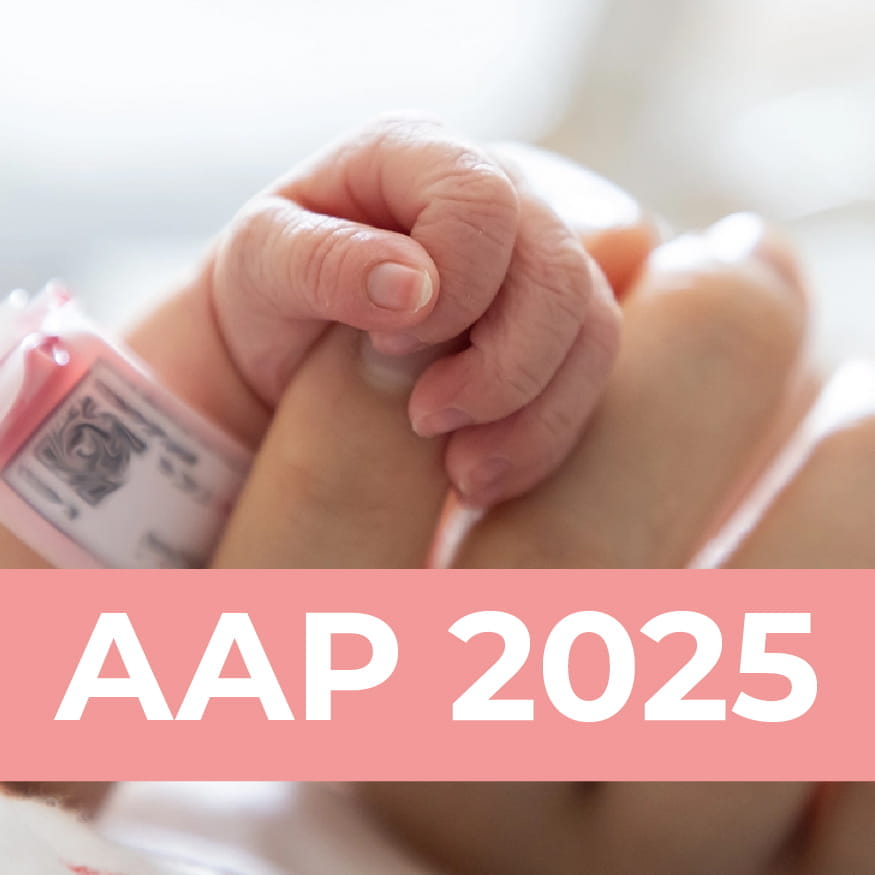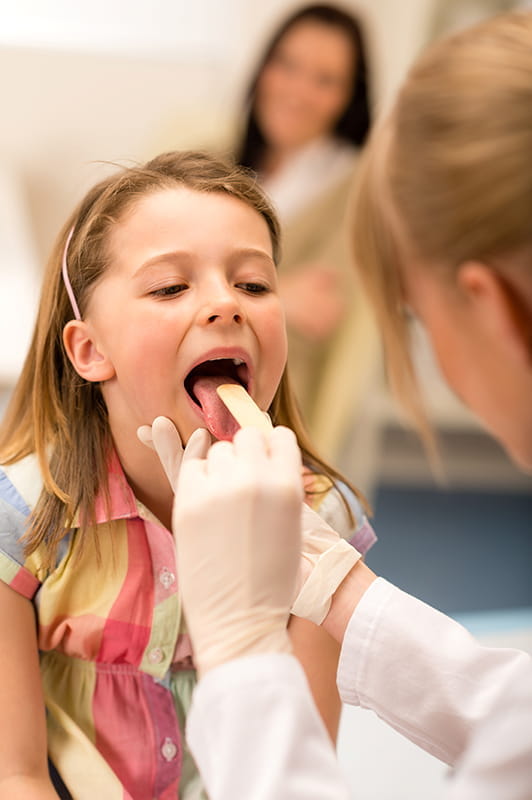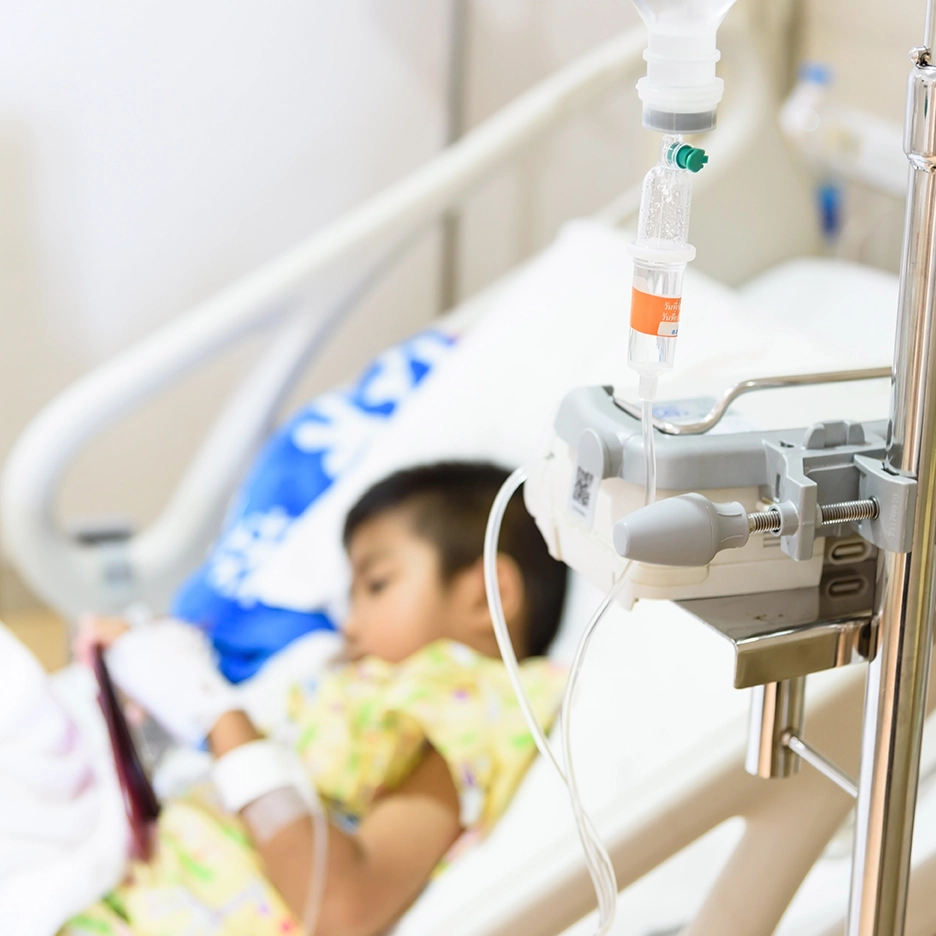ESPID 2024: Oral Presentation: Respiratory Infections
Increased Risk of Respiratory Syncytial Virus Hospitalization in Infants with a Family History of Asthma- Marie Bilard
The data presented is part of an exploratory analysis from the Respiratory Syncytial Virus Consortium in Europe (RESCEU) birth cohort study. The study was conducted across five hospitals in Spain, the Netherlands, Finland, Scotland, and England. Infants were recruited at birth, and parents completed questionnaires at baseline and again when the child was one year old to capture RSV (Respiratory Syncytial Virus) hospitalization data during the first year of life. A subset of these children was followed until the age of three, and the study has since been extended to six years to investigate the development of childhood asthma. A significant gap in understanding RSV's burden is whether RSV infection contributes to the development of childhood asthma. It is known that children who suffer severe RSV infections are more likely to wheeze and develop asthma later in childhood. However, it remains unclear whether RSV infection directly causes asthma or if both conditions are due to a shared genetic predisposition.
The objective of this presentation is to explore the relationship between genetic predisposition to asthma and the risk of RSV hospitalization before 12 months of age. Genetic predisposition was defined based on a family history of asthma reported by parents at baseline. RSV hospitalization data was obtained from parental reports and validated with medical records. Importantly, all participating hospitals systematically tested for RSV during the study. The main analysis from the RESCEU study, which involved 9,466 infants, was published last year. Currently, the analysis focuses on over 9,000 children for whom data on family history of asthma was available. The study examined the frequency of RSV hospitalization in the first year of life relative to the family history of asthma. Children with a family history of asthma, particularly if the mother or a sibling had asthma, showed an increased risk of RSV hospitalization. A family history of asthma in fathers did not show a significant association with RSV hospitalization. A deeper analysis of the maternal history of asthma revealed a significant correlation, with a relative risk (odds ratio) of about two. Further analysis showed that the increased risk of RSV hospitalization in children with a maternal history of asthma was more pronounced after the first three months of life. Hospitalization rates were similar during the first 90 days, regardless of maternal asthma history. However, as the children aged, those with a maternal asthma history were hospitalized at a higher rate compared to those without.
Additionally, RSV hospitalization trends were assessed according to the month of birth. Based on maternal asthma history, children born between October and December showed little difference in hospitalization rates. This aligns with the previous observation that the first 90 days of life, where exposure to RSV shortly after birth, mitigates the differences in hospitalization rates. The study highlights that a maternal history of asthma is a significant predictor of RSV hospitalization risk in infants, particularly after the first three months of life. The finding underscores the importance of considering genetic predisposition in understanding the burden of RSV and its potential link to childhood asthma.
The findings on the impact of maternal asthma history on the risk of RSV hospitalization in infants were presented. The data indicated a classic trend: children without maternal asthma history showed higher RSV hospitalization rates if born later in the year. However, for children with a maternal asthma history, the birth month did not affect hospitalization frequency. Key observations included that maternal asthma nearly doubled the risk of RSV hospitalization within the first year, especially notable after three months and predominantly after six months. The studysuggests that infants with a maternal asthma history might remain vulnerable to severe RSV infection longer than others. Implications for RSV immunization programs were discussed. Since maternal vaccine protection wanes after six months, children of mothers with asthma might need immunization at the beginning of their first RSV season to ensure coverage beyond six months. The sub-analysis aims to enhance understanding of maternal asthma as a risk factor for RSV hospitalization, which may help address and control genetic predispositions in subsequent childhood asthma studies.
When asked about breastfeeding, the speaker clarified that breastfeeding was not included in the current analysis. However, they acknowledge its known impact on RSV hospitalization and mention that it was observed in a separate analysis. Integrating breastfeeding data into their ongoing research is on their agenda.
Primary Care RSV Disease Characteristics in Infants and Young Children in Germany- Dara from the Prospective PAPI Surveillance Network, 2021-2023 -Martin Wetzke
The speaker discussed the prevalence and impact of RSV in infants and young children, focusing particularly on those with mild to moderate RSV disease managed in outpatient settings. RSV is a common virus that affects nearly all children by the age of two and can lead to severe respiratory illnesses such as bronchiolitis and pneumonia, necessitating hospitalization in about 2% of cases. However, mild to moderate RSV cases, which are much more frequent, often require medical attention in primary care settings. Recent studies have estimated that 14% to 30% of children seek primary care for RSV infections.
The data from the Pediatric Airway Pathogen Incident Study (PAPI), a prospective surveillance study conducted in Germany from 2021 to 2023 during the RSV season, was presented. The study aimed to assess the burden of RSV in outpatient settings. It included children up to 24 months old with respiratory infections from both primary and tertiary care centres. For the outpatient component, five general paediatricians' offices participated, each recruiting at least 12 patients per week who met the inclusion criteria, which included being of the appropriate age and showing at least one symptom of respiratory infection. All participating children underwent nasal swab testing, and their demographic data, disease presentation, and comorbidities were recorded. Follow-up telephone calls were made 14 days after diagnosis, and if symptoms persisted, again at 28 days. The study highlighted the significant burden of mild to moderate RSV disease in outpatient settings, underlining the need for more extensive primary care data to better understand and manage RSV in young children.
A comprehensive study involving 1,450 pediatric patients was discussed, with 1,442 included in the final analysis. The study's population had a mean age of 12 months and an approximately equal gender distribution. It found that 19.7% of the children were RSV positive, 71.7% had other pathogens, and 8.6% had no pathogen detected. The pathogen distribution was observed over time, with a notable drop in swab collection during the holiday season due to pediatric office closures. An unusual RSV season was noted in 2021-2022, with heightened activity in the summer rather than the typical winter season. Among the detected viral pathogens, rhinovirus was the most common, followed by RSV, Boca virus, and adenovirus. Influenza was notably rare during the study period. When comparing RSV-positive and RSV-negative children, no differences were found in age or gender distribution. Classical RSV risk factors such as prematurity or congenital heart disease were not more common in RSV-positive children. However, there was an association between RSV positivity and atopic conditions like eczema and food allergies. Another significant finding was the increased presence of siblings aged 0-5 years in the households of RSV-positive children.
Clinically, RSV-positive children did not show differences in fever, hypoxemia, or extrapulmonary disease compared to their RSV-negative counterparts. However, they exhibited lower respiratory tract involvement, including abnormal breathing sounds indicative of obstructive airway disease. The Pediatric Respiratory Severity Score (PRSS) assessed disease severity, revealing a higher incidence of mild to severe respiratory illness in RSV-positive children.
Regarding treatment, almost all RSV-positive children received some form of drug therapy. Common treatments included albuterol and inhaled saline despite a lack of evidence supporting their use for RSV. Antipyretics and nasal drops were also frequently administered. The speaker highlighted the need for further research into the associations between atopic conditions and RSV, as well as the effectiveness of common treatments used in RSV-positive children. The data provides valuable insights into the epidemiology, clinical presentation, and management of RSV in pediatric populations, emphasizing the unique patterns observed during the atypical RSV season of 2021-2022.
The secondary hospitalization rate in the RSV-positive group was 4.6%. After 14 days, one in four children had persistent symptoms, primarily cough or runny nose, but almost all recovered by four weeks. RSV is a significant, though not leading, pathogen causing acute respiratory infections in children under 24 months in outpatient settings. It is associated with more obstructive airway disease and greater severity. The data also show an association between RSV and an atopic phenotype, with siblings identified as a risk factor. The significant secondary hospitalization rate underscores RSV's impact. This dataset could serve as a reference to monitor the effects of upcoming RSV immunization programs expected in Germany next year. Acknowledgements were given to the PAPI study group and data collectors
The webinar discussed the inclusion of patients up to 24 months old, emphasizing the need for analysis of disease severity, healthcare utilization, and medication use stratified by age categories. This analysis is crucial for understanding the implications of immunization. Additionally, the use of Palivizumab in high-risk children over two seasons may affect the prevalence of risk factors observed in the cohort.
Incidence of Readmission Following Hospitalization for Respiratory Syncytial Virus in Children Under 5 Years Old- Yoonyoung Choi
The speaker delved into the significant impact of RSV as a prevalent cause of respiratory infections worldwide, particularly affecting children under two years old. It highlighted the short and long-term consequences associated with RSV infection, including a notable correlation with invasive pneumococcal disease and the increased risk of recurrent wheezing and asthma later in childhood. However, despite its widespread effects, there's a lack of understanding regarding the risks and reasons for readmission following RSV hospitalization.
To address this gap, the webinar presented findings from a longitudinal cohort study examining the association between RSV Lower Respiratory Tract Infection (LRTI) hospitalization and subsequent readmission compared to influenza (flu) and Human Metapneumovirus (HMPV) in children under five years old. The study, conducted in Utah, USA, between 2019 and 2022, utilized a prospective identification of RSV RTI hospitalizations and retrospective identification of comparison groups with positive test results within three days of admission.
Methodologically, the study employed International Classification of Diseases (ICD) diagnostic codes to determine LRTI, excluding cases outside the index RSV season, those hospitalized for less than 24 hours, and those with concurrent viral or bacterial infections. The outcomes were identified through Electronic Health Record (EHR) systems, with chart reviews conducted by pediatricians to ascertain respiratory-related readmissions. Statistical analyses, including descriptive analysis and Cox models adjusting for confounders like age, gender, race, insurance status, chronic medical conditions, and severity indicators such as length of stay and ICU admission, were performed to elucidate the findings.
A comparative study on RSV, flu, and HMPV was discussed. Key findings highlighted significant differences between these groups. The RSV group was significantly younger than the HMPV group, with a mean age of 14 months at initial admission, and had fewer comorbid conditions, with prematurity being the most common. However, RSV patients had a longer median hospital stay of two days than flu patients. Over the follow-up period, 124 RSV patients, 13 flu patients, and 20 HMPV patients had at least one readmission. Specifically, 110 RSV patients, 3 flu patients, and 4 HMPV patients were readmitted for respiratory issues. The mean age at readmission for RSV patients was 18 months. Among the RSV group, rehospitalized children were more likely to be male and have underlying medical conditions. The study showed that RSV patients had a quicker readmission rate for all causes, though not statistically significant, but a significantly quicker respiratory readmission compared to HMPV. Within the first 30 days, 6% of RSV patients were readmitted for respiratory causes, increasing to 17% over 1.5 years, significantly higher than HMPV. Adjusted analyses showed a four-fold higher risk of respiratory readmission for RSV compared to flu or HMPV.
The speaker discussed outcomes related to respiratory readmission, particularly in young infants, though the results were not statistically significant due to the small sample size. The most common diagnoses for respiratory readmission were bronchiolitis, asthma, and pneumonia. The findings align with previous studies on bronchiolitis, often linked to RSV, highlighting an additional economic burden that policymakers should consider. Minimal exposure specification and active surveillance were noted, though unmeasured confounders like health-seeking behaviour could not be adjusted for, limiting generalizability. The study concludes that RSV lower respiratory tract infection hospitalization significantly increases respiratory readmission risk in children under five, emphasizing the need for widespread RSV immunoprophylaxis. The speaker highlighted asthma was highlighted as the second most common diagnosis among respiratory admissions. The most common diagnosis, however, was bronchiolitis. The speaker also mentioned cases where patients initially admitted with RSV were discharged prematurely, leading to quick readmissions.
Increased Risk of Wheezing Associated with Respiratory Syncytial Virus (RSV) in a Multi-Country Cross-Sectional Survey of 'Parent's Perception- Chiara Cadeddu
The speaker began by introducing RSV as a common infectious virus, acknowledging its burden on healthcare systems. They highlighted their study's aim to address this burden, particularly in relation to hospitalizations due to conditions like acute lower respiratory tract diseases and pneumonia associated with RSV. They emphasized that RSV can exacerbate symptoms of diseases like diabetes and increase the risk of subsequent illness in cancer treatments. The study focused on standardizing risk assessment and hospitalization data related to RSV. The presentation then delved into the study methodology, including interventions such as RS3 transfections and data collection from parents of children affected and unaffected by RSV. Data was gathered through various means, including online platforms and mobile partners, with pre-typed questions totalling 445. Statistical analysis, including logistic regression models, was performed on the collected data. The speaker outlined the inclusion criteria for the study groups: Group one consisted of parents with infants diagnosed with RSV-associated conditions in the past five years or within the first two years of life, while the comparison group had no such diagnoses. The study from April 2023 involved 1,200 parents evenly distributed between the two groups and across different countries. The results of the study indicated significant impacts of RSV infection on children and their families. Firstly, RSV-related hospitalizations accounted for 45% of children in the RSV group, with hospital stays averaging five days. Among these hospitalized children, 42% required admission to pediatric intensive care units, and 60% needed respiratory support.
Regarding symptoms, wheezing was more prevalent in the RSV group (61%) compared to the reference group (23%). The severity of wheezing increased with the severity of RSV infection, with rates ranging from 43% to 80% across different countries. The statistical analysis revealed that wheezing was significantly associated with RSV infection, especially in severe cases requiring intensive care. In terms of healthcare utilization, children with RSV infection had more frequent visits to healthcare professionals compared to the reference group across various healthcare settings, from general practitioners to specialists. This increased healthcare burden was accompanied by a notable impact on the quality of life for both children and their parents. More than half of the parents reported moderate to severe impacts on their emotional well-being and daily activities/social life due to the illness. Furthermore, the study highlighted significant gaps in public knowledge about managing RSV infections, indicating a need for better education and support for parents.
Rate Dynamics and Serotype Distribution of Pneumococcal Otitis Media Necessitating Middle Ear Fluid Culture in Children <24 Months, Southern Israel 2004-2023- Ron Dagan
The impact of Streptococcus pneumoniae (S. pneumoniae) on otitis media was discussed, highlighting its significant role in childhood infections. The speaker noted the challenges in accurately diagnosing otitis media, particularly simple cases, which may be under or over-diagnosed. However, complex episodes are more reliably identified, often requiring middle ear fluid cultures for accurate diagnosis. The presentation focused on the dynamic changes in pneumococcal serotypes causing otitis media in children under two years old in Southern Israel over 19 years, including five years before pneumococcal conjugate vaccine (PCV) implementation. Based on population-based surveillance in Southern Israel, the study involved children under two years old in the Negev District. It included over 8,000 otitis media episodes, of which 28% were pneumococcal. The age distribution showed around 60% of cases under one year old. The introduction of PCV7 and PCV13 led to a rapid decline in overall pneumococcal otitis rates within three years of implementation, followed by stable low rates. Regarding serotypes, the speaker highlighted the impact of PCV introduction on pneumococcal serotypes causing otitis media. PCV7-positive cases decreased significantly post-vaccination, with similar trends for additional serotypes covered by PCV13. Some serotypes not included in earlier vaccines, such as those in PCV20, showed increased rates post-vaccination. However, the overall rates remained low, with non-vaccine serotypes playing a minimal role in otitis media.
The speaker provided an in-depth analysis of pneumococcal serotypes causing otitis media, particularly focusing on 2015 to 2023. They highlighted significant changes in serotype distribution following the introduction of pneumococcal conjugate vaccines (PCVs). PCV7 serotypes saw a notable decrease in occurrence, with only 17 episodes observed during the last period of the study. Among PCV13 serotypes, 90% of episodes were attributed to 19F, 19A, and 3, indicating their persistence. Conversely, serotypes 1, 4, 5, 6A, 6B, 7F, and 9V were absent from cultures since 2015, suggesting their disappearance from otitis media cases. Analysis of PCV20 serotypes revealed 161 episodes, with non-PCV13 PCV20 serotypes constituting 61% of the overall PCV20 cases. Overall, 52% of pneumococcal episodes were PCV20 serotypes, highlighting their significance. In conclusion, the study showed a substantial decline in pneumococcal otitis media rates following PCV implementation, with persistent serotypes such as 19F, 19A, and 3 remaining prevalent. Most pneumococcal cases during the study period were attributed to PCV20 serotypes. The speaker suggested that switching vaccination programs from PCV13 to PCV20 could further reduce pneumococcal otitis media cases, emphasizing the importance of ongoing research to assess vaccine efficacy against emerging serotypes.
European Society for Paediatric Infectious Diseases (ESPID) 2024, 20th May- 24th May 2024, Copenhagen




